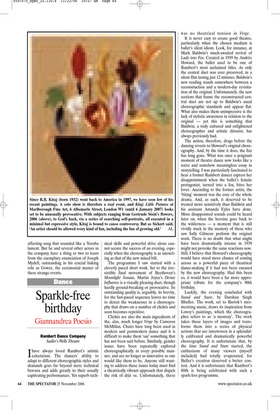Sparkle-free birthday
Giannandrea Poesio
Rambert Dance Company Sadler’s Wells Theatre
Ihave always loved Rambert’s artistic eclecticism. The dancers’ ability to adapt to different choreographic styles and demands goes far beyond mere technical bravura and adds greatly to their usually captivating performances. Yet superb tech nical skills and powerful drive alone cannot secure the success of an evening, especially when the choreography is as unexciting as that of the new mixed bill.
The programme I saw started with a cleverly paced short work. Set to the irresistible final movement of Beethoven’s Moonlight Sonata, Martin Joyce’s Divine Influence is a visually pleasing duet, though hardly ground-breaking or provocative. Its outstanding quality is, arguably, its brevity, for the fast-paced sequence leaves no time to detect the weaknesses in a choreography that draws on a number of clichés and soon becomes repetitive.
Clichés are also the main ingredients of the, alas, much longer Verge by Cameron McMillan. Chairs have long been used in modern and postmodern dance and it is difficult to make them ‘say’ something that has not been said before. Similarly, gender issues have been repeatedly explored choreographically in every possible manner, and are no longer as innovative as one would like them to be. Anyone still wanting to address these issues today must find a theatrically vibrant approach that dispels the risk of déjà vu. Unfortunately, there was no theatrical tension in Verge.
It is never easy to create good theatre, particularly when the chosen medium is ballet’s silent idiom. Look, for instance, at Mark Baldwin’s much-awaited revival of Lady into Fox. Created in 1939 by Andrée Howard, the ballet used to be one of Rambert’s most acclaimed titles. As only the central duet was ever preserved, in a silent film lasting just 12 minutes, Baldwin’s new reading stands somewhere between a reconstruction and a modern-day revisitation of the original. Unfortunately, the new sections that frame the reconstructed central duet are not up to Baldwin’s usual choreographic standards and appear flat. What also makes them unimpressive is the lack of stylistic awareness in relation to the original — yet this is something that Baldwin, a truly cultured and enlightened choreographer and artistic director, has always previously had.
The action, therefore, drags before the dancing reverts to Howard’s original choreography. And, by the time it does, the fizz has long gone. What was once a poignant moment of theatre dance now looks like a naive and somehow meaningless essay in storytelling. I was particularly fascinated to hear a former Rambert dancer express her disappointment when the ballet’s female protagonist, turned into a fox, bites her lover. According to the former artist, the ‘biting’ moment was the core of the whole drama. And, as such, it deserved to be treated more sensitively than Baldwin and his assistant Amanda Eyles have done. More disappointed sounds could be heard later on, when the heroine goes back to the wilderness — a moment that is still vividly stuck in the memory of those who saw Sally Gilmour perform the original work. There is no doubt that what might have been dramatically intense in 1939 might not provoke the same reactions now. Still, I believe that Howard’s choreography would have stood more chance of coming across as a powerful piece of theatrical dance-making if it had not been encased by the new choreography. Had this been so, it would have been a far more appropriate tribute for the company’s 80th birthday.
Luckily, the evening concluded with Stand and Stare, by Darshan Singh Bhuller. The work, set to Bartok’s mesmerising music, draws its inspiration from Lowry’s paintings, which the choreographer refers to as ‘a memory’. The work takes those layers of images and transforms them into a series of physical actions that are interwoven in a splendidly calibrated and dramatically powerful choreography. It is unfortunate that, by the time Stand and Stare started, the enthusiasm of many viewers (myself included) had totally evaporated, for Buller’s creation deserved a better context. And it is unfortunate that Rambert’s 80th is being celebrated with such a spark-less programme.


























































































 Previous page
Previous page